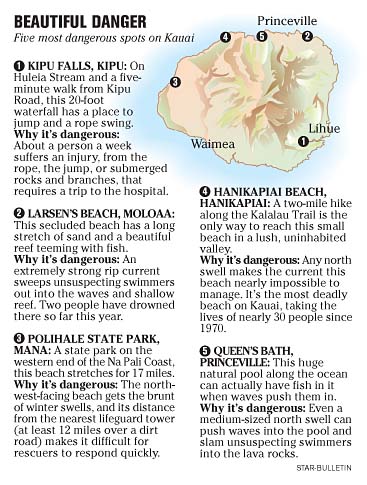KAUAI: DANGER LURKING IN BEAUTY
Officials want risky sites out of books
STORY SUMMARY »
PUHI, Kauai » The beautiful, secluded Kipu Falls is one of Kauai's most beautiful and most dangerous attractions.
It's typical of many tourist attractions on Kauai -- beautiful and exciting when conditions are right, and dangerous, if not deadly, when the weather does not cooperate.
Kauai ranks tops in the state when it comes to drownings as compared to population. So the Kauai Visitors Bureau is trying to work with guidebook writers to keep people out of Kauai's dangerous areas and onto protected beaches.
Guidebook writers say, however, that they provide a service -- giving accurate information to readers so they can assess the situation for themselves.
FULL STORY »
KIPU, Kauai » Kipu Falls, just 10 minutes from downtown Lihue, fits the description of a swimmer's paradise with a 20-foot waterfall and a deep pool ringed by jungle.
It's also a source of serious injury and death, with an average of one person a week winding up in the Wilcox Hospital emergency room seeking treatment for injuries sustained at the popular attraction. About twice a month, injuries, from broken bones and cuts to rope burns in the most sensitive regions, are serious enough to require surgery, said Dr. Monte Downs, an emergency room doctor at Wilcox Hospital.
Two people have died there in the past five years after hitting their heads while using a rope swing. Others have had to be rescued via helicopter in flash floods.
"For us in the ER, it's one of the first questions we ask," Downs said. "We just roll our eyes and say, 'Oh, Kipu Falls?'"
But the small waterfall is only one of several Kauai tourist destinations, mostly unmarked and without facilities, that can turn deadly for tourists.
Kauai officials are trying to persuade authors of tour books to stop directing readers to some of the Garden Isle's dangerous attractions.
Kauai, which averages about 10 drownings a year, has the highest rate of drownings, per capita, of any of the major islands, according to the state Department of Health's statistics. More than 70 percent of Kauai's drowning victims are tourists, compared to less than 50 percent statewide.
With only seven of the roughly 50 beaches on Kauai currently covered by lifeguards (funding for coverage at two other beaches was passed by the Legislature this year), tourists often go looking for that secluded tropical beach off the beaten path and get in trouble.
It is not a problem specific to Kauai, Downs said. Other islands have similar attractions that turn deadly with certain weather conditions.
But it is a problem the Kauai Visitors Bureau is trying to manage, said its director, Sue Kanoho.
The visitors bureau's plan is to motivate tourists to use the beaches that are staffed by lifeguards, and, since ocean conditions change quickly, to give them as up-to-date information as possible on its Web site and via phone.
"Our strength as an island (tourist destination) is the ocean," Kanoho said, but "it could be a weakness if you don't understand it."
Despite the visitors bureau's best efforts, however, tourists often turn to guidebooks for information. And, despite Kanoho's best efforts, guidebooks continue to promote places like Kipu Falls.
Kanoho said she's written to guidebook authors, trying to keep them from promoting Kipu Falls (or encourage people to take guided tours there), as well as to avoid Polihale State Park and Queen's Bath in Princeville.
Only three of the dozen or so book writers responded, she said. Even those who did cited their rights to free speech under the First Amendment.
Andrew Doughty, author of the "Ultimate Kauai Guide," the highest-selling Kauai tour book, was one of the recipients of the letter, according to Kanoho. He didn't respond.
Kipu Falls, he said, has been a popular destination for decades. And his book describes the dangers at the waterfall, even adding more stringent language in their newest edition.
"In the end, it's what it appears to be," Doughty added. "A rope, on a tree, in the wilderness. Hawaii is not Disneyland."
Doughty said he's received a lot of suggestions, and many of them (including the increased warnings about Kipu) have made it into the book.
But as for Kanoho's suggestion about Polihale, "asking us to not tell visitors where places that have public access, public facilities and public camp sites seems odd," Doughty said.
The goal of a guidebook writer, he continued, is to provide as accurate information as possible, so that the reader can make an informed decision on how to spend their vacation.
Downs, the ER doctor, however, said he would like to see more specific information about the dangers of Kauai's tourist spots, but realizes that to completely remove information from books is unrealistic.
For Kipu, he'd like to see guidebooks cite the fact that a person a week ends up at the hospital and that a high number of people get injured or drown at Queen's Bath and Larsen's.
But, Downs added, "The visitor industry doesn't like skull and crossbones."
It often works, however.
At Hanakapiai, one of Kauai's deadliest beaches over the past two decades, a homemade sign with notches marking the number of dead has kept a number of tourists from entering the water.
At Kipu last week, Christos Makropoulos and Xanthi Tigami of Greece followed their guidebook to the falls. But after hearing about the injuries sustained there, they decided not to jump.
"I'm afraid of heights anyway," Tigami said.


